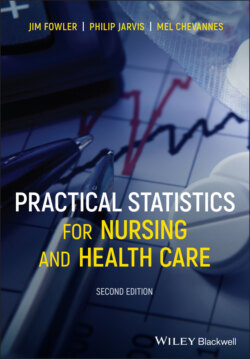Читать книгу Practical Statistics for Nursing and Health Care - Jim Fowler - Страница 18
2.7 Simple Random Sampling
ОглавлениеIn a simple random sampling design, every individual in the study population has an equal chance of being included in the sample. That is to say, steps are taken to avoid bias in the sampling. In our asthma example above, the population being sampled is all patients registered with the GP practice who are known to have asthma (say, 800). To select a simple random sample of size n = 20, each patient (‘sampling unit’) is assigned a unique number: 1, 2, 3, and so on, until all 800 patients have been numbered. Then 20 numbers in the range 1–800 are selected at random, and the patients (sampling units) corresponding to these numbers represent the sample.
First, use may be made of random number tables. Appendix A is such a table. The numbers are arranged in groups of five in rows and columns, but this arrangement is arbitrary. Starting at the top left corner, you may read: 2, 3, 1, 5, 7, 5, 4 …; or 23, 15, 75, 48, …; or 231, 575, 485 …; or 23.1, 57.5, 48.5, 90.1, …; and so on, according to your needs. When you have obtained the numbers you need for your investigation, mark the place in pencil. Next time, carry on where you left off. It is possible that a random number will prescribe a subject (sampling unit) that has already been drawn. In this event, ignore the number and take the next random number. The purpose is to eliminate your prejudice as to which items should be selected for measurement. Unfortunately, observer bias, conscious or unconscious, is notoriously difficult to avoid when gathering data in support of a particular hunch!
Second, many calculators and statistical software have a facility for generating random numbers. For example, within LibreOffice Calc spreadsheet typing ‘=RAND()’ within a cell and pressing <Enter> generates a random number between 0.0 and 1.0 in the form of a decimal fraction, e.g. 0.2771459. To generate more random decimal fractions use the mouse to drag the lower right corner of the cell containing the results of applying the ‘=RAND()’ function down the required number of rows. Please note that many spreadsheets have an auto‐update function whereby formulae are updated after each calculation. To avoid this copy the column of random numbers you have generated and then go to a new cell, right button click your mouse and select ‘Paste Special’ and tick the ‘Numbers’ box and then ‘OK.’ Once you have fixed the random decimal fractions you may use this to provide a set of integers, 2, 7, 7, 1 by multiplying by 10 and using the first digit only; or 27, 71, 45, … by multiplying by 100; or 277, 145; or 2.7, 7.1; and so on, according to your needs.
Random sampling is the preferred approach to sampling. Although it does not guarantee that a representative sample is taken from the study population (due to sampling error, described in Section 10.1), it gives a better chance than any other method of achieving this.
